Overview
- Brief Narrative
- Eternal light lamp issued by Yad Vashem and acquired by Sol Oster around the time the Hall of Remembrance, the first commemorative site at Yad Vashem, was built in 1961. Sol lived in Berlin, Germany, with his family during the establishment of the Nazi dictatorship following the appointment of Hitler as Chancellor in 1933. Sol’s father, Isaac Ossowski, was a prominent member of the Jewish community and the family was repeatedly questioned by the SS (Schutzstaffel; Protection Squadrons) who gathered intelligence on opponents of the Nazi state and policed racial purity. Fourteen year old Sol told his father that he wanted to leave Germany to attend a seminary and, in 1934, he was sent to a yeshiva in Ponevezh ( Panevezys), Lithuania. In December 1936, Sol received a notice to register with the German embassy. Afraid that his passport would be confiscated, he applied to a seminary in London and went into hiding. In June 1937, he received his acceptance letter which he needed to get a student visa for England. After completing his studies in London in 1939, he joined his family in the United States, where they had emigrated between 1936 and 1938.
- Date
-
emigration:
1939
use: approximately 1961
- Geography
-
use:
United States
- Credit Line
- United States Holocaust Memorial Museum Collection, Gift of Sol Oster
- Contributor
-
Subject:
Sol Oster
- Biography
-
Sally (Sol) Ossowski was born on January 1, 1919, in Berlin, Germany, to Frieda Schwartzbardt, born in 1888, and Rabbi Issac Ossowski, born in 1877 in Lubraniez, Poland. Sol had two brothers, Leo, born on April 1, 1913, and Joseph, born in 1914, in Pfungstadt, and a sister, Nettie. His father was a prominent and active member of the Jewish community, serving as a shochet [ritual slaughterer], mohel [practioner of ritual circumcision], sofer [scribe], and cantor. The family attended the Alte Schul synagogue where Sol sang in the choir. He attended the Jewish Community School for Boys until he was 14 years old and was active in sports, plays, and clubs.
By the early 1930s, and especially after Hitler's appointment as Chancellor in 1933, Sol noticed a change within society as people’s attitudes towards Jews began to change in response to the anti-Semitic policies of the Nazi government. The Ossowski family was the target of anti-Semitic behaviours and attacks, much of this due to his father's prominent position within the Jewish community. Some of Sol's friends stopped playing with him and neighbors no longer said hello. Members of the Hitler Youth attacked Sol on the subway, yelling “Jew, get out”, and attempted to open the doors of the moving train; Sol escaped, but not one person helped him. One day as they were on their way to temple, two SS (Schutzstaffel; Protection Squadrons) guards took Sol, his brothers, and father into the basement of a bar. Sol managed to escape, but was captured and returned; a neighbour talked the SS into letting them go. Another time, the SS forced their way into their home looking for contraband.
As a result of this incident, Sol decided he wanted to leave Germany. Isaac supported this decision and made arrangements for him to attend seminary outside of Germany. Sol left in 1934 for a yeshiva in Ponevezh (Panevezys), Lithuania. He wanted to emigrate to Palestine and help establish a Jewish state. His brother, Joseph, got a visa for the United States with the help of a cousin, and emigrated in 1936. He sent Sol money for his living expenses. In December 1936, Sol received a letter from the German government requiring German citizens to register with the embassy in Kaunas and to hand in their passports. He was terrified that if he complied he would be stateless and unable to leave Lithuania. Sol believed emigration to Palestine was no longer an option. An Arab revolt in 1936 resulted in the British severely limiting immigration. He discussed his plight with Rabbi Kahaneman, the head of the Yeshiva. They decided that Sol should apply to the Tree of Life seminary in London. Sol no longer felt safe in Lithuania. Pro-Nazi groups were active in the country and anti-Semitism was growing stronger throughout the country. He decided to go into hiding in the Jasnegurke forest in January 1937. A farmer allowed him to live in his barn. Food was brought to him by the Green family whom he had lived with while in school. The mother, a cook at the Yeshiva, made food for Sol which her daughter brought to him. Once he received his acceptance letter from the seminary in June 1937, Sol came out of hiding and left for London via Denmark. He stayed for one week in Copenhagen with a local Rabbi before securing a ticket to London from the Joint Distribution Committee, a Jewish humanitarian assistance organization that aided German Jews in their flight from Nazi Europe. He entered England on a student visa in June 1937.
Sol’s parents and sister left Germany for the United States via Belgium in 1938, having changed their name from Ossowski to Oster. Sol completed university and emigrated to the U.S. in 1939. He married Frieda Perl on December 20, 1947, and they had a son. He was the longest tenured rabbi at Temple Beth Israel-Shaare Zedek in Lima, Ohio, serving for more than 40 years. He retired in 1992, and was bestowed the honor of rabbi emeritus by his congregation. Leo died in 2008, Joseph in 2009, and his wife, Frieda, in 2011. Sol died on August 25, 2011, in Hilliard, Ohio at age 92.
Physical Details
- Language
- Hebrew
- Classification
-
Jewish Art and Symbolism
- Category
-
Jewish ceremonial objects
- Object Type
-
Sanctuary lamps (aat)
- Physical Description
- a. Brass colored metal lamp with an attached brown electric cord with a 2 prong plug for North American voltage. At the top is a circle with the top and sides cut out, leaving a U-shaped space. Within this space is a plastic lamp socket with a small, round light bulb. A thick, round band encircles the collar where it narrows and connects to the base. A round piece of metal with a small side hole and an opening on the end protrudes from the collar. The base is a rectangular frame with a smaller, rectangular opening; the frame is embossed with Hebrew text and has a rough, textured background. On the underside is an opening for the reducer, a threaded, circular metal extension. It has a round, thin, knurled locknut and is incised with a diamond pattern. The reverse of the base is shiny and smooth.
b. Dark brown metal, H-shaped table mount with 4 feet riveted to the corners. Two pieces of rectangular metal extend vertically from the base, with the side edges bent forward, creating a slot into which the lamp base (a) slides. - Dimensions
- a: Height: 5.620 inches (14.275 cm) | Width: 2.500 inches (6.35 cm) | Depth: 2.370 inches (6.02 cm)
b: Height: 2.620 inches (6.655 cm) | Width: 4.750 inches (12.065 cm) | Depth: 1.750 inches (4.445 cm) - Materials
- a : metal, plastic, glass, rubber
b : metal - Inscription
- a. front, bottom, stamped : Hebrew text
Rights & Restrictions
- Conditions on Access
- No restrictions on access
- Conditions on Use
- No restrictions on use
Keywords & Subjects
Administrative Notes
- Legal Status
- Permanent Collection
- Provenance
- The sanctuary lamp was donated to the United States Holocaust Memorial Museum in 1992 by Rabbi Sol Oster, the son of Isaac Ossowski.
- Record last modified:
- 2022-07-28 18:22:10
- This page:
- https://collections.ushmm.org/search/catalog/irn7124
Download & Licensing
In-Person Research
- By Appointment
- Request 21 Days in Advance of Visit
- Plan a Research Visit
- Request to See This Object
Contact Us
Also in Isaac Ossowski family collection
The collection consists of artifacts, documents, photographs, and publications relating to the experiences of Isaac Ossowski and his family in Germany before the Holocaust.
Date: 1760-1961
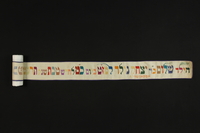
Handpainted linen Torah binder made for a German Jewish boy
Object
Torah wimpel created to celebrate the birth of Sally (Sol) Ossowski on January 1, 1919, by his father, Isaac Ossowski, in Berlin, Germany in the 1930s. The hand painted inscription and decorations proclaim his birth and tell his parents to raise him according to Jewish law. A binder is a textile band used like a belt to hold closed the two staves of the Torah scroll when it is not in use. Rabbi Ossowski was a prominent member of the Jewish community in Berlin. He was head shochet [ritual slaughterer], mohel [practitioner of ritual circumcision], sofer [scribe], and hazan [cantor, musical prayer leader] at the Alte Shul [Old Synagogue]. After Hitler was appointed Chancellor in 1933, increasingly severe sanctions were enacted against Jews. The Ossowski family was repeatedly questioned by the SS (Schutzstaffel; Protection Squadrons) who gathered intelligence on opponents of the Nazi state and policed racial purity. In 1934, Isaac sent his youngest son, 14 year old Sol, to Lithuania to study at a yeshiva. In 1936, his sons, Joseph and Leo, left for the United States. In 1938, Isaac and his wife, Frida, and their daughter, Nettie, escaped Nazi Germany and joined Joseph in the US. Sol joined them there in 1939.
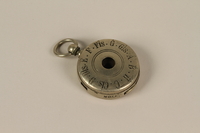
Circular silver 12 tone pocket watch style pitch pipe and case used by a cantor
Object
Tuning device used to set a musical pitch used by Isaac Ossowski, who, as a hazan [cantor], would lead the congregation in musical prayers. Rabbi Ossowski was a prominent member of the Jewish community in Berlin, Germany. He was head shochet [ritual slaughterer], mohel [practitioner of ritual circumcision], sofer [scribe], as well as hazan, at the Alte Shul [Old Synagogue]. After Hitler was appointed Chancellor in 1933, increasingly severe sanctions were enacted against Jews. Isaac was repeatedly questioned by the SS (Schutzstaffel; Protection Squadrons) who gathered intelligence on opponents of the Nazi state and policed racial purity. In 1934, he sent his youngest son, 14 year old Sally (Sol), to Lithuania to study at a yeshiva. In 1936, his sons, Joseph and Leo, left for the United States. In 1938, Isaac and his wife, Frida, and their daughter, Nettie, escaped Nazi Germany and joined Joseph in the US. Sol joined them there in 1939.
![Der Baalschem von Michelstadt : Kulturgeschichte. Erzahlung [Book] Der Baalschem von Michelstadt : Kulturgeschichte. Erzahlung [Book]](https://www.ushmm.org/media/emu/get?irn=7130&mm_irn=16783&file=secondary)
Der Baalschem von Michelstadt : Kulturgeschichte. Erzahlung [Book]
Object
Cultural history book from the library of Isaac Ossowski, a prominent member of the Jewish community in Berlin, Germany, who emigrated in 1938 to avoid the increasing persecution of Jews by the government of Nazi Germany. It is a narrative of the culture, history, and traditions of the Hasidic movement. The greeting card probably was received by Sol Oster for his ninth birthday in 1925. It offers blessings for Yom Kippur, best wishes for the New Year, and birthday congratulations. Rabbi Ossowski was head shochet [ritual slaughterer], mohel [practitioner of ritual circumcision], sofer [scribe], and hazan [cantor/musical prayer leader] at the Alte Shul [Old Synagogue]. After Hitler was appointed Chancellor in 1933, increasingly severe sanctions were enacted against Jews. Isaac was repeatedly questioned by the SS (Schutzstaffel; Protection Squadrons) who gathered intelligence on opponents of the Nazi state and policed racial purity. In 1934, he sent his youngest son, 14 year old Sally (Sol), to Lithuania to study at a yeshiva. In 1936, his sons, Joseph and Leo, left for the United States. In December 1936, Sol received a notice to register with the German embassy. Afraid that his passport would be confiscated, Sol applied to a seminary in London and went into hiding. He needed an acceptance letter to get a student visa for England and when it arrived in June 1937, he left for London. In 1938, Isaac and his wife, Frida, and their daughter, Nettie, escaped Nazi Germany and joined Joseph in the US. Sol joined them there in 1939.
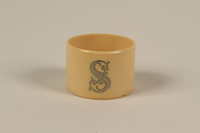
Napkin ring with a silver initial S used for Passover seder by a Jewish refugee
Object
Napkin ring used to mark the place at Pesach seder for Sol Oster (Ossowski) who left Germany and then Lithuania to escape the increasingly violent anti-Semitism of those countries during the 1930s. Sol’s father, Rabbi Isaac Ossowski, was a prominent member of the Jewish community in Berlin, Germany. After Hitler was appointed Chancellor in 1933, increasingly severe sanctions were placed upon Jews. The family was targeted repeatedly by the SS (Schutzstaffel; Protection Squadrons.) Fourteen year old Sol told his father that he wanted to leave Germany to attend a seminary and, in 1934, he was sent to a yeshiva in Ponevezh (Panevezys), Lithuania. In December 1936, Sol received a notice to register with the German embassy. Afraid that his passport would be confiscated, Sol applied to a seminary in London and went into hiding. He needed an acceptance letter to get a student visa for England and when it arrived in June 1937, he left for London. After completing his studies in 1939, he joined his parents in the United States, where they had emigrated a year earlier.
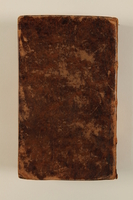
Prayer book
Object
Siddur with special prayers for Shavout and Hashanoh Rabah from the library of Isaac Ossowski, a prominent member of the Jewish community in Berlin, Germany, who emigrated in 1938 to avoid the increasing persecution of Jews by the government of Nazi Germany. It is a narrative of the culture, history, and traditions of the Hasidic movement. Rabbi Ossowski was head shochet [ritual slaughterer], mohel [practioner of ritual circumcision], sofer [scribe], and hazan [cantor or musical prayer leader] at the Alte Shul [Old Synagogue]. After Hitler was appointed Chancellor in 1933, increasingly severe sanctions were enacted against Jews. The Ossowski family was repeatedly questioned by the SS (Schutzstaffel; Protection Squadrons) who gathered intelligence on opponents of the Nazi state and policed racial purity. In 1934, Isaac sent his youngest son, 14 year old Sol, to Lithuania to study at a yeshiva. In 1936, his sons, Joseph and Leo, left for the United States. In 1938, Isaac and his wife, Frida, and their daughter, Nettie, escaped Nazi Germany and joined Joseph in the US. Sol joined them there in 1939.
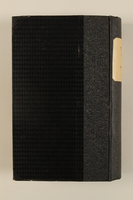
Book
Object
Book codifying Jewish law with specific laws for the ordination of a Rabbi from the library of Isaac Ossowski, a prominent member of the Jewish community in Berlin, Germany, who emigrated in 1938 to avoid the increasing persecution of Jews by the government of Nazi Germany. It is a narrative of the culture, history, and traditions of the Hasidic movement.
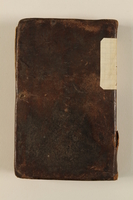
Prayer book
Object
Prayer book from the library of Sol Oster. The book was given to him as a present by his maternal great-uncle, Shalom Dantziger who had used the book for years himself. Dantziger was a mohel in Berlin, Germany, in the early 20th century. In 1933, Hitler was elected Chancellor of Germany and by the summer, the Nazi dictatorship was firmly established. Increasingly severe sanctions were placed upon Jews. Sol’s father, Isaac, was a prominent member of a major synagogue in Berlin and the family was targeted repeatedly by the SS (Schutzstaffel; Protection Squadrons.) Fourteen year old Sol told his father that he wanted to leave Germany to attend a seminary and, in 1934, he was sent to a yeshiva in Ponevezh,( Panevezys)Lithuania. In December 1936, Sol received a notice to register with the German embassy. Afraid that his passport would be confiscated, Sol applied to a seminary in London and went into hiding. Friends from the yeshiva and a local farmer provided him food and a place to stay. In June 1937, he received his acceptance letter which he needed to get a student visa for England. After completing his studies in London in 1939, he joined his family in the United States, where they had emigrated between 1936 and 1938.
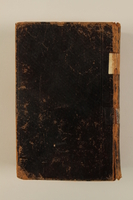
Book
Object
Shulchan Aruch, an authoritative source of Jewish law, from the library of Sol Oster, who as a young man, left Germany and then Lithuania to escape the increasingly violent anti-Semitism of those countries in the late 1930s. The book was given to him as a present by his maternal great-uncle, Shalom Dantziger who had used the book for years himself. Dantziger was a mohel in Berlin, Germany, in the early 20th century. The postcard was written in 1919 Berlin to Yehiel (or Yisrael) Rubenstein. The style, with the frequent use of God Willing and similar language, suggests that the writer was a very pious person. Sol’s father, Rabbi Isaac Ossowski, was a prominent member of the Jewish community in Berlin, Germany. He was head shochet [ritual slaughterer], mohel [practitioner of ritual circumcision], sofer [scribe], and hazan [cantor, musical prayer leader] at the Alte Shul [Old Synagogue]. After Hitler was appointed Chancellor in 1933, increasingly severe sanctions were placed upon Jews. The family was targeted repeatedly by the SS (Schutzstaffel; Protection Squadrons.) Fourteen year old Sol told his father that he wanted to leave Germany to attend a seminary and, in 1934, he was sent to a yeshiva in Ponevezh (Panevezys), Lithuania. In December 1936, Sol received a notice to register with the German embassy. Afraid that his passport would be confiscated, Sol applied to a seminary in London and went into hiding. He needed an acceptance letter to get a student visa for England and when it arrived in June 1937, he left for London. After completing his studies in 1939, he joined his parents in the United States, where they had emigrated a year earlier.
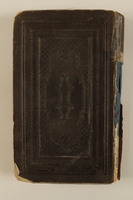
Prayer book
Object
Pentateuch in Russian from the library of Isaac Ossowski, a prominent member of the Jewish community in Berlin, Germany, who emigrated in 1938 to avoid the increasing persecution of Jews by the government of Nazi Germany. It is a narrative of the culture, history, and traditions of the Hasidic movement. Rabbi Ossowski was head shochet [ritual slaughterer], mohel [practitioner of ritual circumcision], sofer [scribe], and hazan [cantor or musical prayer leader] at the Alte Shul [Old Synagogue]. After Hitler was appointed Chancellor in 1933, increasingly severe sanctions were enacted against Jews. Isaac was repeatedly questioned by the SS (Schutzstaffel; Protection Squadrons) who gathered intelligence on opponents of the Nazi state and policed racial purity. In 1934, he sent his youngest son, 14 year old Sally (Sol), to Lithuania to study at a yeshiva. In 1936, his sons, Joseph and Leo, left for the United States. In 1938, Isaac and his wife, Frida, and their daughter, Nettie, escaped Nazi Germany and joined Joseph in the US. Sol joined them there in 1939.
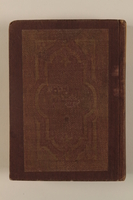
Prayer book
Object
Comprehensive prayer book for daily and holiday prayers from the library of Isaac Ossowski, a prominent member of the Jewish community in Berlin, Germany, who emigrated in 1938 to avoid the increasing persecution of Jews by the government of Nazi Germany. Rabbi Ossowski was head shochet [ritual slaughterer], mohel [practitioner of ritual circumcision], sofer [scribe], and hazan [cantor, musical prayer leader] at the Alte Shul [Old Synagogue]. After Hitler was appointed Chancellor in 1933, increasingly severe sanctions were enacted against Jews. Isaac was repeatedly questioned by the SS (Schutzstaffel; Protection Squadrons) who gathered intelligence on opponents of the Nazi state and policed racial purity. In 1934, he sent his youngest son, 14 year old Sally (Sol), to Lithuania to study at a yeshiva. In 1936, his sons, Joseph and Leo, left for the United States. In 1938, Isaac and his wife, Frida, and their daughter, Nettie, escaped Nazi Germany and joined Joseph in the US. Sol joined them there in 1939.
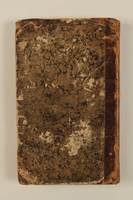
Prayer book
Object
Prayer book for the last 2 days of Passover from the library of Isaac Ossowski, a prominent member of the Jewish community in Berlin, Germany, who emigrated in 1938 to avoid the increasing persecution of Jews by the government of Nazi Germany. It is a narrative of the culture, history, and traditions of the Hasidic movement. Rabbi Ossowski was head shochet [ritual slaughterer], mohel [practitioner of ritual circumcision], sofer [scribe], and hazan [cantor, musical prayer leader] at the Alte Shul [Old Synagogue]. After Hitler was appointed Chancellor in 1933, increasingly severe sanctions were enacted against Jews. Isaac was repeatedly questioned by the SS (Schutzstaffel; Protection Squadrons) who gathered intelligence on opponents of the Nazi state and policed racial purity. In 1934, he sent his youngest son, 14 year old Sally (Sol), to Lithuania to study at a yeshiva. In 1936, his sons, Joseph and Leo, left for the United States. In 1938, Isaac and his wife, Frida, and their daughter, Nettie, escaped Nazi Germany and joined Joseph in the US. Sol joined them there in 1939.
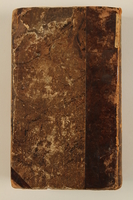
Prayer book
Object
Siddur concerned with the laws of Passover, one volume from a set of 60 titles, from the library of Sol Oster. The book was given to him as a present by his maternal great-uncle, Shalom Danziger who had used the book for years himself. Danziger was a mohel in Berlin, Germany, in the early 20th century. Shalom Dantziger was Sol Oster's great uncle and gave him the Siddur. In 1933, Hitler was elected Chancellor of Germany and by the summer, the Nazi dictatorship was firmly established. Increasingly severe sanctions were placed upon Jews. Sol’s father, Isaac, was a prominent member of a major synagogue in Berlin and the family was targeted repeatedly by the SS (Schutzstaffel; Protection Squadrons.) Fourteen year old Sol told his father that he wanted to leave Germany to attend a seminary and, in 1934, he was sent to a yeshiva in Ponevezh ( Panevezys), Lithuania. In December 1936, Sol received a notice to register with the German embassy. Afraid that his passport would be confiscated, Sol applied to a seminary in London and went into hiding. Friends from the yeshiva and a local farmer provided him food and a place to stay. In June 1937, he received his acceptance letter which he needed to get a student visa for England. After completing his studies in London in 1939, he joined his family in the United States, where they had emigrated between 1936 and 1938.
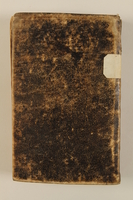
Book
Object
Book codifying Jewish law from the library of Isaac Ossowski, a prominent member of the Jewish community in Berlin, Germany, who emigrated in 1938 to avoid the increasing persecution of Jews by the government of Nazi Germany.
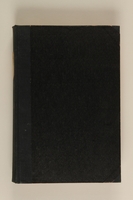
Booklet
Object
Book and other items found inside the book from the library of Isaac Ossowski that were also used by his son, Sol Oster: a book, Universal-Agende für jüdische Kultursbeamte : Handbuch für den Gebrauch in Synagoge, Schule und Haus [Universal liturgy for Jewish cultural officials: Handbook for use in the Synagogue, School, and House]; a pamphlet with 2 articles on Jewish ceremonial law and custom from the series: Writings of the Association for the Preservation of traditional Judaism, and 4 US Army Signal Corps photographs of concentration camp victims. Rabbi Ossowski was a prominent member of the Jewish community in Berlin, Germany, who emigrated in 1938 to avoid the increasing persecution of Jews by the government of Nazi Germany. He was head shochet [ritual slaughterer], mohel [practitioner of ritual circumcision], sofer [scribe], and hazan [cantor, musical prayer leader] at the Alte Shul [Old Synagogue]. After Hitler was appointed Chancellor in 1933, increasingly severe sanctions were enacted against Jews. Isaac was repeatedly questioned by the SS (Schutzstaffel; Protection Squadrons) who gathered intelligence on opponents of the Nazi state and policed racial purity. In 1934, he sent his youngest son, 14 year old Sally (Sol), to Lithuania to study at a yeshiva. In 1936, his sons, Joseph and Leo, left for the United States. In 1938, Isaac and his wife, Frida, and their daughter, Nettie, escaped Nazi Germany and joined Joseph in the US. Sol joined them there in 1939.
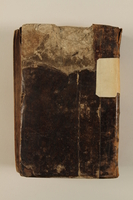
Book
Object
Book codifying Jewish law concerned with "Life Ways," and the Passover liturgy, and also a loose page from another work found inside the book, from the library of Isaac Ossowski, a prominent member of the Jewish community in Berlin, Germany, who emigrated in 1938 to avoid the increasing persecution of Jews by the government of Nazi Germany.
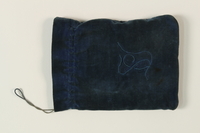
Pair of tefillin with blue velvet bag used by a Jewish refugee
Object
Tefillin and bag used by Isaac Ossowski, a prominent member of the Jewish community in Berlin, Germany, who emigrated in 1938 to avoid the increasing persecution of Jews by the government of Nazi Germany. Tefillin are 2 small black leather boxes containing Torah verses that are worn on the arm and head by Orthodox Jewish males during morning prayers. Rabbi Ossowski was head shochet [ritual slaughterer], mohel [practitioner of ritual circumcision], sofer [scribe], and hazan [cantor, or musical prayer leader] at the Alte Shul [Old Synagogue]. After Hitler was appointed Chancellor in 1933, increasingly severe sanctions were enacted against Jews. Isaac was repeatedly questioned by the SS (Schutzstaffel; Protection Squadrons) who gathered intelligence on opponents of the Nazi state and policed racial purity. In 1934, he sent his youngest son, 14 year old Sally (Sol), to Lithuania to study at a yeshiva. In 1936, his sons, Joseph and Leo, left for the United States. In 1938, Isaac and his wife, Frida, and their daughter, Nettie, escaped Nazi Germany and joined Joseph in the US. Sol joined them there in 1939.
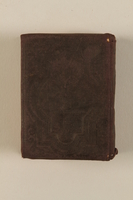
Prayer book
Object
Sider Theilas Jsrael (sic) , a miniature prayer book from the library of Isaac Ossowski, a prominent member of the Jewish community in Berlin, Germany, who emigrated in 1938 to avoid the increasing persecution of Jews by the government of Nazi Germany. Rabbi Ossowski was head shochet [ritual slaughterer], mohel [practitioner of ritual circumcision], sofer [scribe], and hazan [cantor] at the Alte Shul [Old Synagogue]. After Hitler was appointed Chancellor in 1933, increasingly severe sanctions were enacted against Jews. Isaac was repeatedly questioned by the SS (Schutzstaffel; Protection Squadrons) who gathered intelligence on opponents of the Nazi state and policed racial purity. In 1934, he sent his youngest son, 14 year old Sally (Sol), to Lithuania to study at a yeshiva. In 1936, his sons, Joseph and Leo, left for the United States. In 1938, Isaac and his wife, Frida, and their daughter, Nettie, escaped Nazi Germany and joined Joseph in the US. Sol joined them there in 1939.
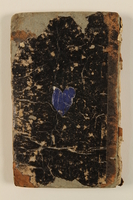
Book
Object
Guidebook of Jewish laws in Russian for the raising of children from the library of Sol Oster. It had been used by his mother, Frida Schwartzbard Ossowski, and her family during her childhood.
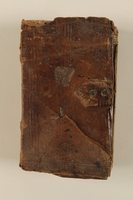
Book
Object
Shulchan Aruch, a book that codifies Jewish law, from the library of Sol Oster. It had been used by his mother, Frida Schwartzbard Ossowski, and her family during her childhood.
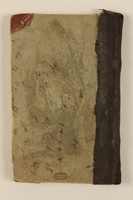
Prayer book
Object
Prayer book for Tisha B'Av, a day of communal mourning, from the library of Isaac Ossowski, a prominent member of the Jewish community in Berlin, Germany, who emigrated in 1938 to avoid the increasing persecution of Jews by the government of Nazi Germany. The prayers in the book commemorate the destruction of the first and second temples in Jerusalem. An additional section includes pre-lamentory prayers. Rabbi Ossowski was head shochet [ritual slaughterer], mohel [practioner of ritual circumcision], sofer [scribe], and Hazan [cantor, a musical prayer leader] at the Alte Shul [Old Synagogue]. After Hitler was appointed Chancellor in 1933, increasingly severe sanctions were enacted against Jews. The Ossowski family was repeatedly questioned by the SS (Schutzstaffel; Protection Squadrons) who gathered intelligence on opponents of the Nazi state and policed racial purity. In 1934, Isaac sent his youngest son, 14 year old Sol, to Lithuania to study at a yeshiva. In 1936, his sons, Joseph and Leo, left for the United States. In 1938, Isaac and his wife, Frida, and their daughter, Nettie, escaped Nazi Germany and joined Joseph in the US. Sol joined them there in 1939.
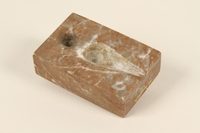
Portable marble Hanukkah menorah with 4 sections made for a rabbi
Object
Traveling Hanukkah lamp used by Rabbi Isaac Ossowski. The lamp was made by a stone mason in Berlin, Germany, in the 1920s. It was meant to have an original design unlike a traditional lamp and created for use as a mobile lamp. A Hanukkah lamp holds eight candles for the eight nights of Hanukkah; the ninth candle is the shamash [attendant] that is used to light the other candles. Because of their religious significance, the Hanukkah lights cannot be used in everyday ways, such as providing light. Traditionally, menorah refers only to the original seven branched lamp that stayed lit in the Temple; the nine branched lamp is a hanukiyah or Hanukkah lamp. Rabbi Ossowski was a prominent member of the Jewish community in Berlin. He was head shochet [ritual slaughterer], mohel [practioner of ritual circumcision], sofer [scribe], and hazan [cantor or musical prayer leader] at the Alte Shul [Old Synagogue]. After Hitler was appointed Chancellor in 1933, increasingly severe sanctions were enacted against Jews. The Ossowski family was repeatedly questioned by the SS (Schutzstaffel; Protection Squadrons) who gathered intelligence on opponents of the Nazi state and policed racial purity. In 1934, Isaac sent his youngest son, 14 year old Sol, to Lithuania to study at a yeshiva. In 1936, his sons, Joseph and Leo, left for the United States. In 1938, Isaac and his wife, Frida, and their daughter, Nettie, escaped Nazi Germany and joined Joseph in the US. Sol joined them there in 1939.
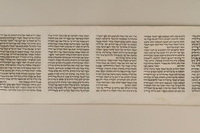
Megillat, Book of Esther, scroll handwritten by a sofer for Isaac Ossowski
Object
Book of Esther scroll or Megillat Esther handwritten by an unknown sofer for Isaac Ossowski, a prominent member of the Jewish community in Berlin, Germany, who emigrated in 1938 to avoid the increasing persecution of Jews by the government of Nazi Germany. Rabbi Ossowski was head shochet [ritual slaughterer], mohel [practioner of ritual circumcision], sofer, and hazan [cantor or musical prayer leader] at the Alte Shul [Old Synagogue]. After Hitler was appointed Chancellor in 1933, increasingly severe sanctions were enacted against Jews. The Ossowski family was repeatedly questioned by the SS (Schutzstaffel; Protection Squadrons) who gathered intelligence on opponents of the Nazi state and policed racial purity. In 1934, Isaac sent his youngest son, 14 year old Sol, to Lithuania to study at a yeshiva. In 1936, his sons, Joseph and Leo, left for the United States. In 1938, Isaac and his wife, Frida, and their daughter, Nettie, escaped Nazi Germany and joined Joseph in the US. Sol joined them there in 1939.
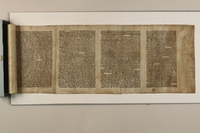
Megillat, Book of Esther, scroll handwritten by a sofer for Isaac Ossowski
Object
Book of Esther scroll or Megillat Esther handwritten by an unknown sofer for Isaac Ossowski, a prominent member of the Jewish community in Berlin, Germany, who emigrated in 1938 to avoid the increasing persecution of Jews by the government of Nazi Germany. Rabbi Ossowski was head shochet [ritual slaughterer], mohel [practioner of ritual circumcision], sofer, and hazan [cantor or musical prayer leader] at the Alte Shul [Old Synagogue]. After Hitler was appointed Chancellor in 1933, increasingly severe sanctions were enacted against Jews. The Ossowski family was repeatedly questioned by the SS (Schutzstaffel; Protection Squadrons) who gathered intelligence on opponents of the Nazi state and policed racial purity. In 1934, Isaac sent his youngest son, 14 year old Sol, to Lithuania to study at a yeshiva. In 1936, his sons, Joseph and Leo, left for the United States. In 1938, Isaac and his wife, Frida, and their daughter, Nettie, escaped Nazi Germany and joined Joseph in the US. Sol joined them there in 1939.
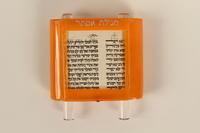
Megillat, Book of Esther, scroll handwritten by a sofer for Isaac Ossowski
Object
Book of Esther scroll or Megillat Esther, perhaps made for a child, handwritten by an unknown sofer for Isaac Ossowski, a prominent member of the Jewish community in Berlin, Germany, who emigrated in 1938 to avoid the increasing persecution of Jews by the government of Nazi Germany. Rabbi Ossowski was head shochet [ritual slaughterer], mohel [practioner of ritual circumcision], sofer, and hazan [cantor or musical prayer leader] at the Alte Shul [Old Synagogue]. After Hitler was appointed Chancellor in 1933, increasingly severe sanctions were enacted against Jews. The Ossowski family was repeatedly questioned by the SS (Schutzstaffel; Protection Squadrons) who gathered intelligence on opponents of the Nazi state and policed racial purity. In 1934, Isaac sent his youngest son, 14 year old Sol, to Lithuania to study at a yeshiva. In 1936, his sons, Joseph and Leo, left for the United States. In 1938, Isaac and his wife, Frida, and their daughter, Nettie, escaped Nazi Germany and joined Joseph in the US. Sol joined them there in 1939.
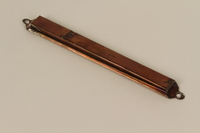
Mezuzah in a copper metal case used by a Jewish refugee family
Object
Mezuzah and case that belonged to Isaac Ossowski, a prominent member of the Jewish community in Berlin, Germany, who emigrated in 1938 to avoid the increasing persecution of Jews by the government of Nazi Germany. According to the Torah, every doorpost in a Jewish home should display a mezuzah, a small parchment scroll inscribed with two chapters from Deuteronomy, including the Shema, a central prayer of Judaism and the source of this law. The scroll is enclosed in a case so that it can be affixed to the right doorpost. It serves as a reminder of the covenant of faith and a notice that this is an observant Jewish home. Rabbi Ossowski was head shochet [ritual slaughterer], mohel [practitioner of ritual circumcision], sofer [scribe], and hazan [canter or musical prayer leader] at the Alte Shul [Old Synagogue]. After Hitler was appointed Chancellor in 1933, increasingly severe sanctions were enacted against Jews. Isaac was repeatedly questioned by the SS (Schutzstaffel; Protection Squadrons) who gathered intelligence on opponents of the Nazi state and policed racial purity. In 1934, he sent his youngest son, 14 year old Sally (Sol), to Lithuania to study at a yeshiva. In 1936, his sons, Joseph and Leo, left for the United States. In 1938, Isaac and his wife, Frida, and their daughter, Nettie, escaped Nazi Germany and joined Joseph in the US. Sol joined them there in 1939.
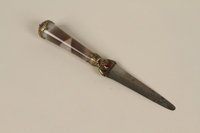
Circumcision knife with inscription and agate handle with wooden case used by a mohel
Object
Ritual circumcision or milah knife set used by Isaac Ossowski, a highly respected mohel who left Berlin because of the targeted persecution of Jews by the government of Nazi Germany. A mohel is a person qualified to perform the Jewish ceremony of brit (bris) milah, the ritual circumcision of a male, Jewish child. This requires both extensive religious training and surgical skill. A milah knife is sharp on both edges to avoid hesitation during use that might cause unnecessary pain to the child. Rabbi Ossowski was a prominent member of the Jewish community in Berlin. He was head shochet [ritual slaughterer], mohel [practioner of ritual circumcision], sofer [scribe], and hazan [cantor or musical prayer leader] at the Alte Shul [Old Synagogue]. After Hitler was appointed Chancellor in 1933, increasingly severe sanctions were enacted against Jews. The Ossowski family was repeatedly questioned by the SS (Schutzstaffel; Protection Squadrons) who gathered intelligence on opponents of the Nazi state and policed racial purity. In 1934, Isaac sent his youngest son, 14 year old Sol, to Lithuania to study at a yeshiva. In 1936, his sons, Joseph and Leo, left for the United States. In 1938, Isaac and his wife, Frida, and their daughter, Nettie, escaped Nazi Germany and joined Joseph in the US. Sol joined them there in 1939.
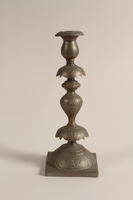
Pair of Sabbath candlesticks with wax reservoirs owned by a Jewish refugee
Object
Pair of Shabbat candleholders that belonged to Isaac Ossowski, a prominent member of the Jewish community in Berlin who left Germany because of the targeted persecution of Jews by the Nazi government. Rabbi Ossowski was a prominent member of the Jewish community in Berlin. He was head shochet [ritual slaughterer], mohel [practioner of ritual circumcision], sofer [scribe], and hazan [cantor or musical prayer leader] at the Alte Shul [Old Synagogue]. After Hitler was appointed Chancellor in 1933, increasingly severe sanctions were enacted against Jews. The Ossowski family was repeatedly questioned by the SS (Schutzstaffel; Protection Squadrons) who gathered intelligence on opponents of the Nazi state and policed racial purity. In 1934, Isaac sent his youngest son, 14 year old Sol, to Lithuania to study at a yeshiva. In 1936, his sons, Joseph and Leo, left for the United States. In 1938, Isaac and his wife, Frida, and their daughter, Nettie, escaped Nazi Germany and joined Joseph in the US. Sol joined them there in 1939.
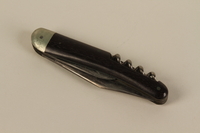
Pocket knife with leather case carried by a Jewish refugee
Object
Folding knife and case that belonged to Isaac Ossowski, a prominent member of the Jewish community in Berlin who left Germany because of the targeted persecution of Jews by the Nazi government. Rabbi Ossowski was a prominent member of the Jewish community in Berlin. He was head shochet [ritual slaughterer], mohel [practioner of ritual circumcision], sofer [scribe], and hazan [cantor or musical prayer leader] at the Alte Shul [Old Synagogue]. After Hitler was appointed Chancellor in 1933, increasingly severe sanctions were enacted against Jews. The Ossowski family was repeatedly questioned by the SS (Schutzstaffel; Protection Squadrons) who gathered intelligence on opponents of the Nazi state and policed racial purity. In 1934, Isaac sent his youngest son, 14 year old Sol, to Lithuania to study at a yeshiva. In 1936, his sons, Joseph and Leo, left for the United States. In 1938, Isaac and his wife, Frida, and their daughter, Nettie, escaped Nazi Germany and joined Joseph in the US. Sol joined them there in 1939.
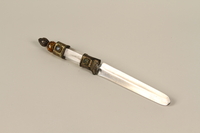
Circumcision knife with a glass and metal handle with a black wooden case used by a mohel
Object
Ritual circumcision [milah] knife and case used by Isaac Ossowski, a highly respected mohel who left Berlin because of the targeted persecution of Jews by the government of Nazi Germany. A mohel is a person qualified to perform the brit (bris) milah, the ritual circumcision of a male, Jewish child. The training includes both the medical procedures and extensive knowledge of Jewish laws and traditions. Rabbi Ossowski was a prominent member of the Jewish community in Berlin. He was head shochet [ritual slaughterer], mohel [practioner of ritual circumcision], sofer [scribe], and hazan [cantor or musical prayer leader] at the Alte Shul [Old Synagogue]. After Hitler was appointed Chancellor in 1933, increasingly severe sanctions were enacted against Jews. The Ossowski family was repeatedly questioned by the SS (Schutzstaffel; Protection Squadrons) who gathered intelligence on opponents of the Nazi state and policed racial purity. In 1934, Isaac sent his youngest son, 14 year old Sol, to Lithuania to study at a yeshiva. In 1936, his sons, Joseph and Leo, left for the United States. In 1938, Isaac and his wife, Frida, and their daughter, Nettie, escaped Nazi Germany and joined Joseph in the US. Sol joined them there in 1939.
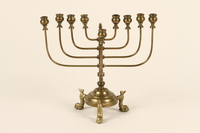
Brass Hanukkah menorah with fish shaped feet used by a Jewish refugee family
Object
Hanukiyah used by Isaac Ossowski and his family, made by Joseph Romiger, Stuttgart, Germany. The family would be forced to leave Berlin in 1938 because of the targeted persecution of Jews by the government of Nazi Germany. Each child in the Ossowski family had their own hanukkah lamp. A Hanukkah candelabrum holds eight candles for the eight nights of Hanukkah; the ninth candle is the shamash [attendant] that is used to light the other candles. Because of their religious significance, the Hanukkah lights cannot be used in everyday ways, such as providing light. Traditionally, menorah refers only to the original seven branched lamp that stayed lit in the Temple; the nine branched candelabrum is a hanukiyah or Hanukkah lamp. Rabbi Ossowski was a prominent member of the Jewish community in Berlin. He was head shochet [ritual slaughterer], mohel [practioner of ritual circumcision], sofer [scribe], and hazan [cantor or musical prayer leader] at the Alte Shul [Old Synagogue]. After Hitler was appointed Chancellor in 1933, increasingly severe sanctions were enacted against Jews. The Ossowski family was repeatedly questioned by the SS (Schutzstaffel; Protection Squadrons) who gathered intelligence on opponents of the Nazi state and policed racial purity. In 1934, Isaac sent his youngest son, 14 year old Sol, to Lithuania to study at a yeshiva. In 1936, his sons, Joseph and Leo, left for the United States. In 1938, Isaac and his wife, Frida, and their daughter, Nettie, escaped Nazi Germany and joined Joseph in the US. Sol joined them there in 1939.
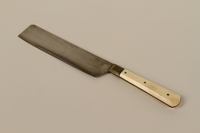
Ritual slaughter knife with a wooden case used by a shochet
Object
Shechita [ritual slaughter] knife and case used by Isaac Ossowski, the head shochet for the Alte Shule in Berlin who left the country because of the targeted persecution of Jews by the government of Nazi Germany. A shochet is specially trained in the laws and procedures of shehitah, the Jewish religious and humane method of slaughtering animals and poultry. It requires years of study in the laws of shechita, as well as animal anatomy and pathology. Rabbi Ossowski was a prominent member of the Jewish community in Berlin. He was head shochet [ritual slaughterer], mohel [practioner of ritual circumcision], sofer [scribe], and hazan [cantor or musical prayer leader] at the Alte Shul [Old Synagogue]. After Hitler was appointed Chancellor in 1933, increasingly severe sanctions were enacted against Jews. The Ossowski family was repeatedly questioned by the SS (Schutzstaffel; Protection Squadrons) who gathered intelligence on opponents of the Nazi state and policed racial purity. In 1934, Isaac sent his youngest son, 14 year old Sol, to Lithuania to study at a yeshiva. In 1936, his sons, Joseph and Leo, left for the United States. In 1938, Isaac and his wife, Frida, and their daughter, Nettie, escaped Nazi Germany and joined Joseph in the US. Sol joined them there in 1939.
![Calligraphy of a graveside Kaddish created by a sofer [scribe] Calligraphy of a graveside Kaddish created by a sofer [scribe]](https://www.ushmm.org/media/emu/get?irn=7125&mm_irn=16787&file=secondary)
Calligraphy of a graveside Kaddish created by a sofer [scribe]
Object
Calligraphy with the text of a graveside prayer created by Isaac Ossowski, which was originally framed and displayed in his home. A Kaddish prayer comes in many forms, but all praise God and sanctify his name. This is a more expressive version of the Kaddish than that which is commonly used today. Mourners would stand near the grave and face Jerusalem while reciting the graveside or burial Kaddish. Rabbi Ossowski was a prominent member of the Jewish community in Berlin. He was head shochet [ritual slaughterer], mohel [practioner of ritual circumcision], sofer [scribe], and hazan [cantor, musical prayer leader] at the Alte Shul [Old Synagogue]. After Hitler was appointed Chancellor in 1933, increasingly severe sanctions were enacted against Jews. The Ossowski family was repeatedly questioned by the SS (Schutzstaffel; Protection Squadrons) who gathered intelligence on opponents of the Nazi state and policed racial purity. In 1934, Isaac sent his youngest son, 14 year old Sol, to Lithuania to study at a yeshiva. In 1936, his sons, Joseph and Leo, left for the United States. In 1938, Isaac and his wife, Frida, and their daughter, Nettie, escaped Nazi Germany and joined Joseph in the US. Sol joined them there in 1939.
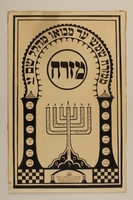
Mizrach, a sign designating the direction of Jerusalem, with a personal inscription created by a sofer
Object
Mizrach poster created by Isaac Ossowski in honor of his wife, Frida's, birthday. A mizrach [mizrachl means east] is a decorative item placed in a traditional Jewish home to indicate the east, the direction of Jerusalem and the direction to face for prayers. This work was originally framed and hung on the east wall of their home. Rabbi Ossowski was a prominent member of the Jewish community in Berlin. He was head shochet [ritual slaughterer], mohel [practioner of ritual circumcision], sofer [scribe], and hazan [cantor or musical prayer leader] at the Alte Shul [Old Synagogue]. After Hitler was appointed Chancellor in 1933, increasingly severe sanctions were enacted against Jews. The Ossowski family was repeatedly questioned by the SS (Schutzstaffel; Protection Squadrons) who gathered intelligence on opponents of the Nazi state and policed racial purity. In 1934, Isaac sent his youngest son, 14 year old Sol, to Lithuania to study at a yeshiva. In 1936, his sons, Joseph and Leo, left for the United States. In 1938, Isaac and his wife, Frida, and their daughter, Nettie, escaped Nazi Germany and joined Joseph in the US. Sol joined them there in 1939.
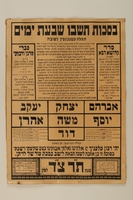
Calligraphy of Sukkot prayers and a personal inscription created by a sofer
Object
Welcome prayers for the festival of Sukkot (Succoth), or Feast of Tabernacles, with an inscription in honor of the birth of his son, Shalom, hand painted by Rabbi Isaac Ossowski in the fall of 1933. It was originally framed for display in their home. During the seven nights of the festival, which is similar to a harvest festival, celebrants are to build and have their meals in a succah or temporary hut built in remembrance of the forty years the Jewish people lived in the desert before reaching the Promised Land. The poster includes all the basic prayers for use inside the sukkah: the prayer for entering, a special prayer for the Sabbath in the sukkah, a prayer inviting the 7 Ushpizin, the main guests at dinner each night of Sukkot: Abraham, Isaac, Jacob, Joseph, Moses, Aaron, and David, and a prayer recited upon exiting the sukkah. Rabbi Ossowski was a prominent member of the Jewish community in Berlin. He was head shochet [ritual slaughterer], mohel [practioner of ritual circumcision], sofer [scribe], and hazan [cantor or musical prayer leader] at the Alte Shul [Old Synagogue]. After Hitler was appointed Chancellor in 1933, increasingly severe sanctions were enacted against Jews. The Ossowski family was repeatedly questioned by the SS (Schutzstaffel; Protection Squadrons) who gathered intelligence on opponents of the Nazi state and policed racial purity. In 1934, Isaac sent his youngest son, 14 year old Sol, to Lithuania to study at a yeshiva. In 1936, his sons, Joseph and Leo, left for the United States. In 1938, Isaac and his wife, Frida, and their daughter, Nettie, escaped Nazi Germany and joined Joseph in the US. Sol joined them there in 1939.
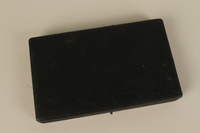
Ritual circumcision set with 2 knives, a case, 2 shields, a suction tube, and scissors used by a mohel
Object
Brit milah set with 7 items: 2 mila knives, 2 guides (Mogen or shields), a glass suction tube, scissors, and case used by Isaac Ossowski, a highly respected mohel who left Berlin because of the targeted persecution of Jews by the government of Nazi Germany. A mohel is a person qualified to perform the brit (bris) milah, the ritual circumcision of a male, Jewish child. The training includes both the medical procedures and extensive knowledge of Jewish laws and traditions. Rabbi Ossowski was head shochet [ritual slaughterer], mohel [practioner of ritual circumcision], sofer [scribe], and hazan [cantor or musical prayer leader] at the Alte Shul [Old Synagogue]. After Hitler was appointed Chancellor in 1933, increasingly severe sanctions were enacted against Jews. The Ossowski family was repeatedly questioned by the SS (Schutzstaffel; Protection Squadrons) who gathered intelligence on opponents of the Nazi state and policed racial purity. In 1934, Isaac sent his youngest son, 14 year old Sol, to Lithuania to study at a yeshiva. In 1936, his sons, Joseph and Leo, left for the United States. In 1938, Isaac and his wife, Frida, and their daughter, Nettie, escaped Nazi Germany and joined Joseph in the US. Sol joined them there in 1939.
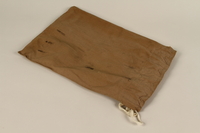
Ritual slaughter instrument set: 3 knives, 3 cases, 2 whetstones, a bag, a band, and 4 cloths used by a shochet
Object
Set of 14 instruments used for shehitah [ritual slaughter]by Isaac Ossowski, the head shochet for the Alte Shule in Berlin who left Germany with his family in 1938 because of the targeted persecution of Jews by the government of Nazi Germany. This set includes 3 knives of different sizes with wooden cases, 2 whetstones to sharpen the knives, and one bag and 4 cloths used to wipe and cover the instruments. A shochet performs shehitah, the Jewish religious and humane method of slaughtering animals and poultry. It requires years of training in the laws and procedures of shehitah, as well as the knowledge of animal anatomy and pathology. Rabbi Ossowski was a prominent member of the Jewish community in Berlin. He was a mohel [practioner of ritual circumcision], sofer [scribe], and hazan[cantor, musical prayer leader], as well as shochet for the Alte Shule [Old Synagogue]. After Hitler was appointed Chancellor in 1933, increasingly severe sanctions were enacted against Jews. The Ossowski family was repeatedly questioned by the SS (Schutzstaffel; Protection Squadrons) who gathered intelligence on opponents of the Nazi state and policed racial purity. In 1934, Isaac sent his youngest son, 14 year old Sol, to Lithuania to study at a yeshiva. In 1936, his sons, Joseph and Leo, left for the United States. In 1938, Isaac and his wife, Frida, and their daughter, Nettie, escaped Nazi Germany and joined Joseph in the US. Sol joined them there in 1939.
Megillat, Book of Esther, scroll with case given to Sol Oster
Object
Book of Esther scroll or Megillat Esther with case from the library of Sol Oster. The printed scroll was given to him in 1936 when he was seventeen years old. Sol left Germany and then Lithuania to escape the increasingly violent anti-Semitism that was developing in those countries in the 1930s. Sol’s father, Rabbi Isaac Ossowski, was a prominent member of the Jewish community in Berlin, Germany. After Hitler was appointed Chancellor in 1933, increasingly severe sanctions were placed upon Jews. The family was targeted repeatedly by the SS (Schutzstaffel; Protection Squadrons.) Fourteen year old Sol told his father that he wanted to leave Germany to attend a seminary and, in 1934, he was sent to a yeshiva in Ponevezh (Panevezys), Lithuania. In December 1936, Sol received a notice to register with the German embassy. Afraid that his passport would be confiscated, Sol applied to a seminary in London and went into hiding. He needed an acceptance letter to get a student visa for England and when it arrived in June 1937, he left for London. After completing his studies in 1939, he joined his parents in the United States, where they had emigrated a year earlier.



